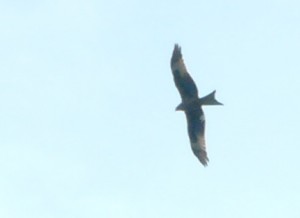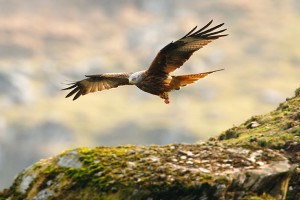by Jamie Girdler
Whether it be the looming silhouette of a Buzzard circling high above or the grayish blur of a Sparrow Hawk whizzing along the hedgerows, there are few sights more exciting than that of a bird of prey, and none more so than the distinctive Red Kite. The forked tail and chestnut-red colouration is immediately recognisable and rather surprisingly a very familiar site to me. I get to witness these magnificent birds almost every day of the week. But how is it that a rare bird I would have had to travel to Mid Wales in hope of spotting a few years ago, is now suddenly thriving on my doorstep (as pictured below), amidst the suburban sprawl of Woodley?

The truth is that once upon a time the Red Kite was as much a London bird as the Ravens in the Tower of London. The streets of Shakespeare’s capital were full of Red Kites. “The city of kites and crows,” he calls it. Surprisingly, Red Kites are neither particularly strong nor aggressive despite being such large birds (with a wingspan of up to five-foot). They are primarily scavengers and opportunists, which is what made them so successful in 16th century London, feeding on the plentiful rubbish in the streets. The Kite is not capable of opening up sheep or lamb carcasses by itself and has to wait until more powerful birds such as Ravens or Buzzards have made the first inroads before it will attempt to feed. Red Kites are however predators and do take a wide variety of live prey such as earthworms, small mammals, amphibians and birds. They usually pair for life, although this is thought to be more because of a mutual attachment to the same territory and nest site, rather than any great attachment to each other. He he.
Persecution meant that these birds were exterminated in England, Scotland and most of Wales by the end of the last century. This was due to a series of vermin acts set out in the 16th century, requiring ‘vermin’ which included the Red Kite to be killed, perceived as a threat to expanding agriculture. Such persecution continued throughout the 17th and 18th centuries and the final blow came towards the end of the 18th century, when increasing numbers of Gamekeepers were employed on country estates. These men were responsible for killing off the final few Kites and by the late 18th century Red Kites had bred for the last time in England and Scotland. If it wasn’t for the initiative of a few local landowners in rural Mid Wales, who had the foresight to safeguard these beautiful birds, the Red Kite would have probably reached extinction, down to only a final few breeding pairs. It is said that the Red Kite was so close to extinction, at one point the entire population of Kites in 1977 emanated from just one female bird!

Over a period of a 100 years efforts to maintain a fragile breeding population were made by committed generations of landowners, rural communities and dedicated individuals. Then in 1903 the first official Welsh Kite Protection Program was established, now the longest continuous conservation project in the world. In 1989 British conservationists began ambitious schemes in the Chilterns to reintroduce Milvus milvus to its former haunts, using a few young Welsh birds. Red Kites started breeding successfully in the Chilterns area and eventually in 1999 up to over 130 breeding pairs were recorded. So successful have the re-introduction programs been that in the latest assessment birds of conservation concern in the UK 2002-2007, the RSPB removed the Red Kite from it’s red list (species of highest concern), to it’s amber list (species of medium conservation concern), an action that was unthinkable when the last assessments were made in 1996.
So the next time you’re out and about, driving down the M40 to your favorite fishing spot, keep a look out for this amazing bird. Alternatively, you could wait a few years and you may see one flying above Nike Town on Oxford Street! Still very much at risk from Egg thieves and the use of illegal poisoned baits, I hope these beautiful birds are allowed to continue there success and grace our skies for centuries to come.